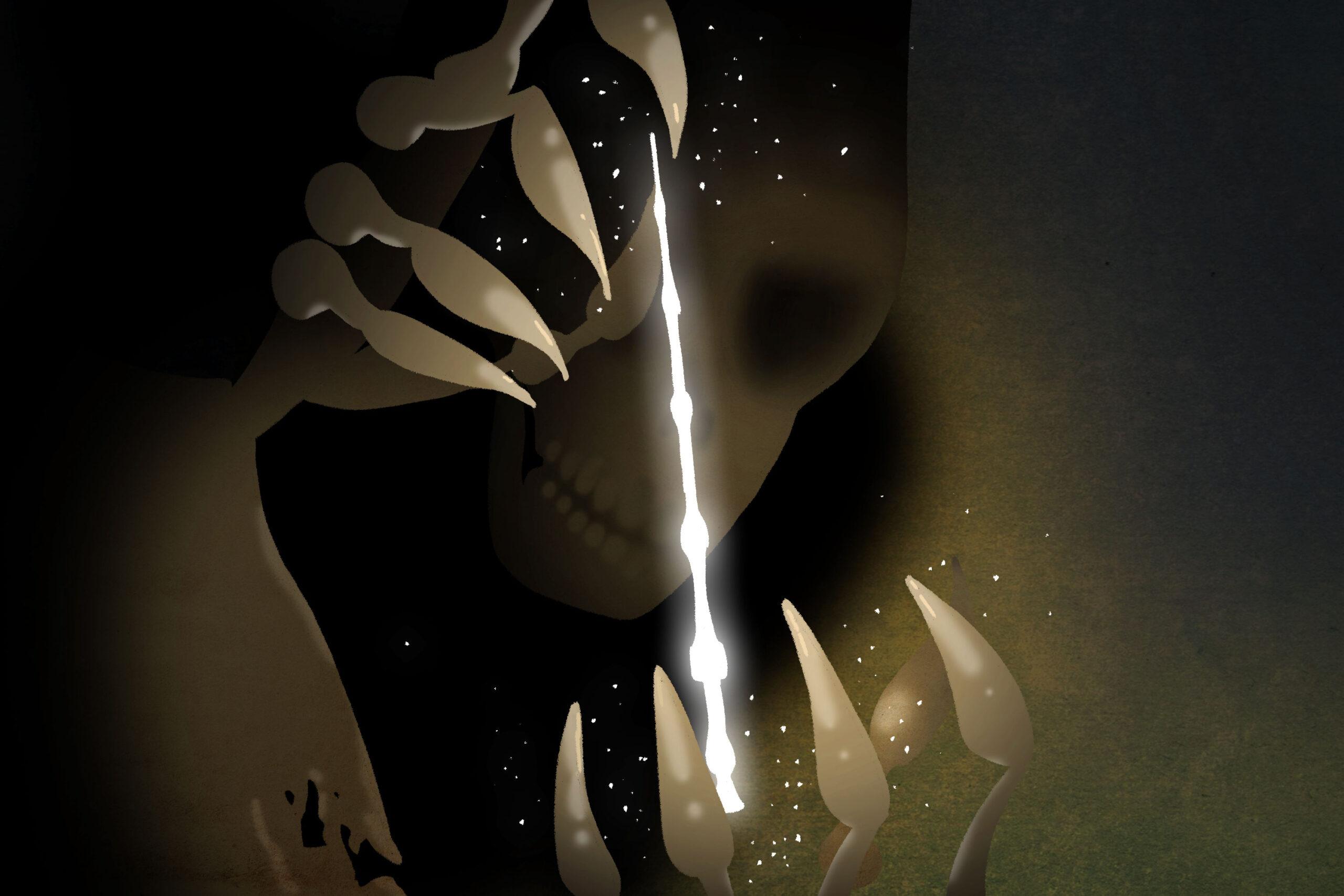Everything You Need to Know About the Elder Wand of ‘Harry Potter’ Lore for ‘Fantastic Beasts: The Crimes of Grindelwald’
The Deathstick. The Wand of Destiny. The legendary object you know from the original series and have surely spotted in almost every tease for the new film. What is it? Why does it matter for ‘Fantastic Beasts’? And what might it tell us about the Dumbledore-Grindelwald relationship?
For a full year, ever since the Fantastic Beasts movie series’s official Twitter account released an enticing photo of two wands side by side, we’ve known that the fabled Elder Wand would play a central role in The Crimes of Grindelwald, the second film in a planned five-part franchise.
So with the sequel to 2016’s Fantastic Beasts and Where to Find Them Apparating into theaters later this week, it’s time to dive into the Potterverse’s Pensieve to consult everything we know about the Elder Wand, wandlore, and the transfer of magical power. From the trailer teases to the marketing efforts to the fact that the wand notably did not appear in the first Beasts film, all signs point to the Elder Wand gaining importance in the follow-up. Let’s go on a journey by examining seven questions about the wand and its possible role in the film. (Because seven, of course, is the most powerfully magical number.)
1. What is the Elder Wand?
Also called the Deathstick and Wand of Destiny, the Elder Wand is an object of immense magical power. Some consider it unbeatable, some merely the most potent means of channeling magic in existence, but either way, it has blazed a long and bloody trail through wizarding history. In addition, the Elder Wand is one of the three Deathly Hallows that gave the seventh Harry Potter book its title. The possessor of all three Hallows—the wand, the Resurrection Stone, and the Cloak of Invisibility—is said to master death.
2. How was it made?
According to the legend related in The Tales of Beedle the Bard, the Elder Wand was a gift from Death to Antioch Peverell, the oldest of the three brothers who inspired “The Tale of the Three Brothers.” According to the musings of Albus Dumbledore, longtime possessor of the wand, though, it—like the other two Hallows—was more likely the invention of a talented wizard with talented siblings, whose creations inspired spurious mythmaking.
The “elder” in Elder Wand doesn’t refer to its age but rather to the wood from which it was crafted; this is the rarest type used to make a wand and, according to J.K. Rowling, “scorns to remain with any owner who is not the superior of his or her company; it takes a remarkable wizard to keep the elder wand for any length of time.” That’s true of the Elder Wand, certainly, and writing in the voice of wandmaker Garrick Ollivander, Rowling adds, “Only a highly unusual person will find their perfect match in elder, and on the rare occasion when such a pairing occurs, I take it as certain that the witch or wizard in question is marked out for a special destiny.”
Inside the 15-inch-long elder shell is a core made from the tail hair of a Thestral, which is a similarly rare wand material that “can be mastered only by a witch or wizard capable of facing death.” Thestrals are the winged reptilian horses Harry and friends use on their rescue mission in Order of the Phoenix; they fit with Hallows lore because the only people who can see Thestrals have themselves witnessed death and gained an emotional understanding of the experience. As her initial series progressed, Rowling once said, she grew surprised nobody ever asked her what magical material formed the core of Dumbledore’s wand. The seventh book showed why that question mattered.
3. What is its ownership history?
Antioch didn’t hold the wand for long. According to Beedle’s legend, the eldest brother’s first step with his new weapon was to challenge a rival wizard to a duel. He won, of course, and “boasted loudly of the powerful wand [that] made him invincible”—which, just as naturally, proved to be the last hubristic claim he’d make.
“That very night,” the story continues, “another wizard crept upon the oldest brother as he lay, wine-sodden, upon his bed. The thief took the wand and, for good measure, slit the oldest brother’s throat.”
Between that initial theft and the early 20th century, when Beasts takes place, the wand traced a more staccato path, with quieter periods punctuated by loud bursts. As Ollivander tells Harry in the middle of Deathly Hallows, “It is perfectly possible to trace the wand’s course through history. There are gaps, of course, and long ones, where it vanishes from view, temporarily lost or hidden; but always it resurfaces.”
The wizards who sought and then possessed the wand for a time were the kinds of wizards one would expect to desire an all-powerful wand, with names like Emeric the Evil and Egbert the Egregious and Barnabas Deverill. (Like George R.R. Martin, Rowling has a way with fantastic fictional names.) Notably, no witch is ever known to have possessed the wand, about which Rowling writes (in the voice of Dumbledore), “Make of that what you will.”
4. How does the wand interact with its master?
Before focusing on the relationship the Elder Wand specifically forges with its possessor, let’s think about wandlore more broadly. Rowling has described wands as “quasi-sentient” and “not exactly animate but … close to it.” Wands choose their wizards, of course—that much we learn as early as Harry’s trip to Ollivander’s shop in Sorcerer’s Stone.
But this relationship goes much further than a mere initial connection. Ollivander later tells Harry that wandworking is “a mutual quest for experience, the wand learning from the wizard, the wizard from the wand,” and in Beedle, Rowling writes (again in Dumbledore’s voice), “Those who are knowledgeable about wandlore will agree that wands do indeed absorb the expertise of those who use them, though this is an unpredictable and imperfect business.”
Indeed, in the “King’s Cross” chapter in Deathly Hallows, Dumbledore theorizes that when Harry’s and Voldemort’s streams crossed in Goblet of Fire thanks to the Priori Incantatem phenomenon, Harry’s wand “imbibed some of the power and qualities of Voldemort’s wand.” Dumbledore goes on to speculate that Harry’s wand from then on “recognized” Voldemort and “regurgitated some of his own magic against him.” Notice those verbs: recognized and regurgitated. Dumbledore ascribes active thought and decision-making to Harry’s wand, and even though this particular connection results from a specific and unique interpersonal relationship, it’s emblematic of a broader pattern of wand-wizard relationships.
The Elder Wand, Rowling shared in a tweet earlier this year, is “more sentient than any other.” This singularity gives the wand powers even beyond its formidable reputation. Rowling writes (again in Dumbledore’s voice) that a wand that has passed through the control of so many dark wizards over so many years would both possess “a marked affinity for the most dangerous kinds of magic” and “accumulate wisdom, strength and power far beyond the ordinary.”
The wand thus becomes “almost an instructor” to subsequent masters. One possessor of the Deathstick, a wizard named Godelot, wrote a guidebook to dark magic and dangerous spells called Magick Moste Evile and attributed much of his learning to his “moste wicked and subtle friend”—yet another instance of the Elder Wand’s personification. Paradoxically, the one possessor of this potentially dangerous weapon who we know maintained mastery for a while was Dumbledore, but as he tells Harry in “King’s Cross,” “I was permitted to tame and to use it, because I took it, not for gain, but to save others from it.” Boasting inspires challengers, and dark magic begets more dark magic, but at least with this one Hallow, Dumbledore was sufficiently wise to spurn its tempting call.
5. How does the wand change owners?
Broadly speaking, any wand is ripe for the taking in a duel. As Ollivander summarizes for Harry in Hallows, “The manner of taking matters. Much also depends upon the wand itself. In general, however, where a wand has been won, its allegiance will change.”
Yet while some thinking, feeling, quasi-sentient wands weigh different factors when determining their master, the Elder Wand knows what it wants. Rowling said in a 2007 PotterCast interview, “The Elder Wand knows no loyalty except to strength. So it’s completely unsentimental. It will only go where the power is.”
She then added an important clarifying line about one’s assumption of ownership of the Elder Wand: “You don’t need to kill with it.”
This attitude parallels that of Ollivander, who tells Harry (italics in the original), “Whether it needs to pass by murder, I do not know. Its history is bloody, but that may be simply due to the fact that it is such a desirable object, and arouses such passions in wizards.”
This nuance was lost on Lord Voldemort, who wrongly assumed Severus Snape held the Elder Wand because he was Dumbledore’s killer, when in reality Draco had disarmed Dumbledore before Snape arrived on the scene, making Malfoy the wand’s true new owner. But Voldemort’s lack of interest in the intricacies and beauty of wandlore was a persistent flaw; he only ever connected wands to power, thinking of them as weapons rather than tools, and thus missed out on a wide range of knowledge. This failure to understand culminated in his downfall in the Great Hall, killed by his own backfiring curse as he tried to use the Elder Wand to smite its true master.
6. What might happen with the wand in The Crimes of Grindelwald?
Maybe Grindelwald will commit crimes with the wand!
Actually, we don’t know if Grindelwald even possesses the Elder Wand at this point. It’s a curious timeline. From the original series, we know that Grindelwald had acquired the wand by the time of the first Beasts movie—in Hallows, we see him take it as a “young man with golden hair”—but as he embodies the persona of Percival Graves in the first Beasts film, he wields a different wand.
Still, in that movie’s climax, Newt captures Grindelwald and Tina uses the Accio spell to take possession of his wand. Does one of them thus become master of the Elder Wand? If so, which one? Here, as Dumbledore says in Half-Blood Prince, we leave the firm foundation of fact and journey instead into thickets of wildest guesswork.
Let’s start by examining a quote Rowling offered in that 2007 PotterCast interview, in which she provided her most in-depth thoughts to date about the Elder Wand’s nature and wand transference in general. About the latter, she said:
I have been asked a lot of times, well what about Duelling Club and so on? Well I think it’s clear there that in practice, where there’s no real weight attached to the transference of a wand, where it’s almost all for fun or purely for competition, there’s no enormous significance attached in either wizard’s mind to a wand flying out of someone’s hand. But there are situations in which the emotional state of wizards where a lot hangs on a duel, that’s something different. That’s about real power and that’s about transference that will have far-reaching effects in some cases. So I think the wand would behave differently then.
A close read of this response suggests that the Beasts climax should have yielded a change; it was an emotionally charged duel about real power, with enormous significance in at least one party’s case as to the outcome. And for purposes of Elder Wand ownership, moreover, it probably shouldn’t matter that the wand Grindelwald/Graves uses when Newt defeats him—and the wand Tina then beckons—isn’t actually the Elder Wand; in Hallows, Harry becomes the master by wrestling a different wand away from Draco. Additionally, a matter of unclear ownership—to which of two conquerors does the wand pledge allegiance, Newt or Tina?—has some precedent; as Xenophilius Lovegood shares in Hallows, at one point in the wand’s history, “the trail goes cold with Arcus and Livius. Who can say which of them really defeated Loxias, and which took the wand?”
Xenophilius doesn’t explore the matter of disputed Elder Wand possession any further, but it’s fair to guess that either Newt or Tina holds it at this point in the Beasts timeline. Fast-forwarding another two decades, we know, or at least we think we know, that Grindelwald has the wand by the time he duels Dumbledore. So we have a sense of Point A (Grindelwald steals the wand) and Point B (Grindelwald is arrested in New York without the wand) and Point Z (Grindelwald has the wand in 1945)—but what happens from C to Y?
There are a few possibilities. Option 1 is that Newt or Tina did obtain unwitting ownership of the Elder Wand and will lose it to Grindelwald later in the Beasts franchise. Option 2 is that these assumptions and extrapolations about existing wandlore knowledge don’t apply to the situation in question, which to be fair is full of oddities—maybe Grindelwald meant to be captured after spending some amount of time operating undercover in the U.S.’s wizarding congress, for example, and thus Rowling’s “enormous significance” rules don’t apply. Grindelwald appears to have physical, if not symbolic and spiritual, possession of the wand in Crimes’ trailers to date, so this theory might be more likely (or, like Voldemort in Hallows, he holds the Elder Wand without fully possessing it). And Option 3 is that even Points A and Z aren’t quite as simple as we think, which brings us to ...
7. And what does it mean for the broader Dumbledore-Grindelwald relationship?
When Harry takes the Hogwarts Express in Stone, his first-ever Chocolate Frog card bears the picture and name of Albus Dumbledore, and the line of description summarizing the headmaster’s accomplishments says he is “particularly famous for his defeat of the Dark wizard Grindelwald in 1945.” In Deathly Hallows, Dumbledore’s friend Elphias Doge writes in an obituary, “They say, still, that no Wizarding duel ever matched that between Dumbledore and Grindelwald.”
Presumably, the five-part Beasts series leads to that fateful duel, which will serve as the climax of the final installment. It would make perfect cinematic sense: As a teen, Dumbledore thought of Grindelwald as a dear friend, possibly unrequited crush, and partner in Hallows obsessing, and after parting ways following the tragedy of his sister’s death, he would have to confront him again decades later with the fate of the wizarding world at stake.
And yet, as the yellow journalist Rita Skeeter teases in Hallows, it’s possible that the magical battle of legend was a more muted encounter. “All I’ll say is, don’t be so sure that there really was the spectacular duel of legend,” she says in an interview promoting her Dumbledore biography. “After they’ve read my book, people may be forced to conclude that Grindelwald simply conjured a white handkerchief from the end of his wand and came quietly!”
For all of Rita’s faults as a journalist, human being, and ethical witch, she usually has the most scandalous facts right. Her other claims about Dumbledore’s past cohere with the truth we learn from both Albus and Aberforth—could the allegation about the duel be true too?
We don’t know much about the actual encounter, as even Dumbledore is circumspect about the details. In the King’s Cross conversation in Hallows, all he tells Harry is “I delayed meeting [Grindelwald] until finally, it would have been too shameful to resist any longer. People were dying and he seemed unstoppable, and I had to do what I could. Well, you know what happened next. I won the duel. I won the wand.”
“I won the duel. I won the wand.” That’s it. Yet even in that moment, after his death and in his last real appearance in the core Potter series, could our lovable mentor character be skirting the truth once more, as he did time and again throughout the seven books?
Think about how the wand transferred from one master to the next in the most famous cases. Antioch loses the wand in his sleep, Grindelwald steals it out of Gregorovitch’s workshop, Draco gains ownership when Dumbledore doesn’t try to defend himself from Malfoy’s disarming spell, and Harry claims it next after physically pulling Draco’s wand from his Slytherin nemesis’s grasp. In more distant times, one wizard even took it after locking his own father, the wand’s preceding possessor, in the cellar. But notice what’s missing from that list of methods: a good, old-fashioned, mano-a-mano battle. Not counting Dumbledore, we know of only one wizard (Egbert the Egregious) who definitively won the Elder Wand in a duel.
Could that unlikely pattern prove true for the transfer from Grindelwald to Dumbledore as well? It’s a definite possibility, and that Rita Skeeter claim in Hallows is the most compelling clue of all that much more complexity is in store than we can presume to predict just one movie into the Beasts series. We might come closer to understanding after The Crimes of Grindelwald, though—wands might not be beasts in the traditional sense, after all, but they sure are fantastic.

